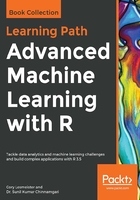
Treating the data
What do I mean when I say let's treat the data? I learned the term from the authors of the vtreat package, Nina Zumel, and John Mount. You can read their excellent paper on the subject at this link: https://arxiv.org/pdf/1611.09477.pdf.
The definition they provide is: processor or conditioner that prepares real-world data for predictive modeling in a statistically sound manner. In treating your data, you'll rid yourself of many of the data preparation headaches discussed earlier. The example with our current dataset will provide an excellent introduction into the benefits of this method and how you can tailor it to your needs. I kind of like to think that treating your data is a smarter version of one-hot encoding.
The package offers three different functions to treat data, but I only use one and that is designTreatmentsZ(), which treats the features without regard to an outcome or response. The functions designTreatmentsC() and designTreatmentsN() functions build dataframes based on categorical and numeric outcomes respectively. Those functions provide a method to prune features in a univariate fashion. I'll provide other ways of conducting feature selection, so that's why I use that specific function. I encourage you to experiment on your own.
The function we use in the following will produce an object that you can apply to training, validation, testing, and even production data. In later chapters, we'll focus on training and testing, but here let's treat the entire data without considerations of any splits for simplicity. There're a number of arguments in the function you can change, but the defaults are usually sufficient. We'll specify the input data, the feature names to include, and minFraction, which is defined by the package as the optional minimum frequency a categorical level must have to be converted into an indicator column. I've chosen 5% and the minimum frequency. In real-world data, I've seen this number altered many times to find the right level of occurrence:
my_treatment <- vtreat::designTreatmentsZ(
dframe = gettysburg_fltrd,
varlist = colnames(gettysburg_fltrd),
minFraction = 0.05
)
We now have an object with a stored treatment plan. Now we just use the prepare() function to apply that treatment to a dataframe or tibble, and it'll give us a treated dataframe:
gettysburg_treated <- vtreat::prepare(my_treatment, gettysburg_fltrd)
dim(gettysburg_treated)
The output of the preceding code is as follows:
[1] 587 54
We now have 54 features. Let's take a look at their names:
colnames(gettysburg_treated)
The abbreviated output of the preceding code is as follows:
[1] "type_catP" "state_catP" "regiment_or_battery_catP"
[4] "brigade_catP" "division_catP" "corps_catP"
As you explore the names, you'll notice that we have features ending in catP, clean, and isBAD and others with _lev_x_ in them. Let's cover each in detail. As for catP features, the function creates a feature that's the frequency for the categorical level in that observation. What does that mean? Let's see a table for type_catP:
table(gettysburg_treated$type_catP)
The output of the preceding code is as follows:
0.080068143100 0.21976149914 0.70017035775
47 129 411
This tells us that 47 rows are of category level x (in this case, Cavalry), and this is 8% of the total observations. As such, 22% are Artillery and 70% Infantry. This can be helpful in further exploring your data and to help adjust the minimum frequency in your category levels. I've heard it discussed that these values could help in the creation of a distance or similarity matrix.
The next is clean. These are our numeric features that have had missing values imputed, which is the feature mean, and outliers winsorized or collared if you specified the argument in the prepare() function. We didn't, so only missing values were imputed.
Speaking of missing values, this brings us to isBAD. This feature is the 1 for missing and 0 if not missing we talked about where I manually coded it.
Finally, lev_x is the dummy feature coding for a specific categorical level. If you go through the levels that were hot-encoded for states, you'll find features for Georgia, New York, North Carolina, Pennsylvania, US (this is US Regular Army units), and Virginia.
My preference is to remove the catP features and remove the clean from the feature name, and change isBAD to isNA. This a simple task with these lines of code:
gettysburg_treated <-
gettysburg_treated %>%
dplyr::select(-dplyr::contains('_catP'))
colnames(gettysburg_treated) <-
sub('_clean', "", colnames(gettysburg_treated))
colnames(gettysburg_treated) <-
sub('_isBAD', "_isNA", colnames(gettysburg_treated))
Are we ready to start building learning algorithms? Well, not quite yet. In the next section, we'll deal with highly correlated and linearly related features.